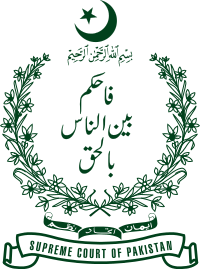Supreme Court of Pakistan
| Supreme Court of Pakistan | |
|---|---|
| عدالت عظمیٰ پاکستان | |

|
|
| Established | 14 August 1947 (As Federal Court) 2 March 1956 (In its modern form) |
| Country | Pakistan |
| Location | Islamabad |
| Coordinates | 33°43′41″N 73°05′55″E / 33.72806°N 73.09861°ECoordinates: 33°43′41″N 73°05′55″E / 33.72806°N 73.09861°E |
| Composition method |
Executive's selection with the Presidential confirmation (Qualifications imposed) |
| Authorized by | Constitution of Pakistan |
| Decisions are appealed to | President of Pakistan for Clemency/Commutation of sentence |
| Judge term length | 65 years of age |
| Website | www.supremecourt.gov.pk |
| Chief Justice of Pakistan | |
| Currently | Hon'ble Justice Saqib Nisar |
| Since | 31 December 2016 |
The Supreme Court of Pakistan (Urdu: عدالت عظمیٰ پاکستان; Adālat-e-Uzma Pākistān) is a highest and an apex court in the judicial hierarchy of Pakistan.
Established in accordance to the Part VII of the Constitution of Pakistan, it has ultimate and extensive appellate, original, and advisory jurisdictions on all courts (including the high courts, district, special and Shariat court), involving issues of federal laws and may act on the verdicts rendered on the cases in context in which it enjoys jurisdiction. In the court system of Pakistan, the Supreme Court is the final arbiter of legal and constitutional dispute as well as final interpreter of constitutional law.
In its modern composition, the Supreme Court is incorporated of Chief Justice of Pakistan, sixteenth justices and two ad-hoc who are confirmed to their appointment by the President upon their nominations from the Prime Minister's selection based on their merited qualifications. Once appointed justices are expected to completed a designated term and then retire, unless their term is terminated through resignation or impeachment by the Supreme Judicial Council resulted in a presidential reference in regards to the misconduct of judge(s). In their discourse judgement, the justices are often categorized as having the conservative, textual, moderate, and liberal philosophies of law in their judicial interpretation of law and judgements.
...
Wikipedia
